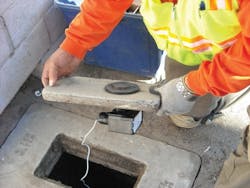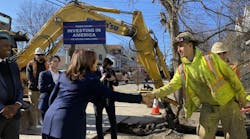By Bimal Adhikary
The Austin Water Utility, serving the city of Austin, TX, is facing the challenge of upgrading and modernizing its water infrastructure to meet growing demand and tackle the water loss caused by leaks and deterioration in many of the older pipelines in the network, some of which were installed in the early part of the 20th century. The utility is currently taking an aggressive approach to upgrading and replacing undersized and deteriorating water mains including the use of trenchless technologies such as pipe bursting, cured-in-place pipe (CIPP) and swage lining methods, which are normally cost effective, less disruptive and time efficient.
Pipe bursting is a method of replacing buried pipes without the need for a traditional construction trench. Launching and receiving pits replace the trench needed by conventional pipe laying. Pneumatic and static pipe bursting equipment are common. Pneumatic tools are typically used for fracturable pipes like clay and concrete. The emergence of new static bursting equipment over the past several years has made the bursting of cast iron, ductile iron and steel pipes and repair sleeves possible.
During pneumatic pipe bursting, the pipe bursting tool is guided through a fracturable host pipe by a constant tension winch. As the tool travels through the pipe, its percussive action effectively breaks apart the old pipe and displaces the fragments into the surrounding soil.
Static systems do not incorporate percussive action to break apart host pipes. They use a configuration of specially designed bladed rollers and an expander to split the host pipe and force the fragmented pipe into the surrounding soil. The process is simple. After the hydraulic bursting unit is positioned in the exit pit, bursting rods are installed through the host pipe and into the launch pit.
Once at the launch pit, crewmembers attach the bladed cutting wheels, bursting head, expander and new High-Density Polyethylene (HDPE) pipe to the bursting rods. The entire configuration is then pulled back through the host pipe by the bursting unit. The bladed cutting wheels split the host pipe. The bursting head and expander displace the burst host pipe while the new HDPE pipe is pulled in simultaneously. The system allows crews to chlorinate water mains before installing them and makes bursting cast iron, ductile iron and steel pipes possible.
Waterline Rehab
The Austin Water Utility asked the Department of Public Works to work on the project of replacing approximately 7,400 linear feet of existing 6" cast iron (CI) pipe with 10" high-density polyethylene (HDPE) pipe along Elroy Road in south Austin using pipe bursting technology. The project was part of the Water Asset Management Program within the Austin Water Utility. The area was experiencing water loss as well as a capacity problem with the existing pipe. It was a good candidate for using a new technology for the first time in the city since the area was sparsely populated, the existing line was undersized and deteriorating, soil conditions and depth of cover over the existing pipe were fairly good and a roadway rehabilitation program was being implemented right after this project.
Since the project was the first of this kind in the City of Austin, it was necessary to do extensive research on the technology, its feasibility and reliability and come up with contract documents including the plans and specification suitable for Austin's contract policy. Since there were no specifications for both pipe bursting and the HDPE pipe in the city's standard specifications, a special specification was written for pipe bursting of water mains and special provision was written for HDPE pipe being used in the project.
The specification for pipe bursting included all the requirements of the equipment, butt fusion methods, experience and certification requirements of the contractor and requirements for testing, temporary water service and disinfection, etc. The special provision to the city's standard specification for pipe included the specification for HDPE pipe and the fittings. Construction plans were prepared showing the location of pipe, approximate locations of pits, service connections, fire hydrants and the valves. The plan set also included works for erosion and sedimentation control, tree protection and traffic control during the construction.
The project was advertised for bid through the city's Contract and Land Management Department and the contract was awarded to Murphy Pipeline Contractors Inc. The project was accomplished using Murphy's pre-chlorinated static pipe bursting technology which did not require any temporary service because the work on each segment, typically 500 feet, was completed each day.
The contractor submitted the final bursting plan with exact locations of launching and receiving pits, locations of hydrants, valves and the service connections for the engineer's review.
The new pipe segments were assembled at a temporary shop using the heat fusion technique and brought to the site pre-chlorinated. The heat butt fusion process forms joints which are permanently leak free and self-restrained against pull out forces. Mechanical Joint (MJ) Adapters were used where fire hydrants and valves were installed. Wall anchors were designed and constructed for pull out forces where the new HDPE pipe is connected to the existing CI and DI pipes.
For this project, high molecular weight, high-density polyethylene (HDPE) pipe per AWWA C906 was specified. The pressure class of the PE pipe and PE fittings were also specified on the basis of the working pressure rating of the water system as defined in AWWA C906. Pressure class 160 psi DR11 PE3608 (PE3408) HDPE manufactured by Performance Pipe was used in the project. A total of 13 fire hydrants and 16 new valves were also installed within the project limit.
All service connections were upgraded to 2" HDPE lines. The service connections were made using horizontal boring in most cases and open trenching in a few locations. The service connections used electro fusion transition saddles.
The bursting was divided into a total of 18 bursts each of approximately 400~500 foot segments and each segment was completed in a day. With some open trenching at some intersections and service connections as well as hydrant and valve locations along with repair/rehabilitation work of pavement, the whole project was completed in less than two months, ahead of the schedule.
During the process, no major problems occurred and traffic was maintained throughout the construction and there was minimal disruption in the neighborhood. The water cut-off to residents was minimal, since the process used pre-chlorination, which was highly appreciated by the residents. The contractor's crews were knowledgeable and they worked closely with the city's engineers and the inspectors.
The total construction cost of the project was approximately $830,000 and design/construction inspection and project management cost was approximately $185,000. The project was funded by Austin Water Utility's Distribution System Engineering Division.
Conclusion
The project was completed with cost saving of approximately 40% over the traditional open trench method to the utility at the same time saving enough time in construction and keeping minimal or no disruption to the traffic and the neighborhood. The successful completion of this project has opened up avenues for other projects to use new technologies in repair and rehabilitation of aging and undersized water mains in the city's water network. In fact, Austin Water Utility is planning at least two projects using CIPP technology and swage lining technology to rehabilitate 6" and 8" CI pipes in the central business district and a highly populated residential neighborhood in central Austin. WW
About the Author: Bimal Adhikary, PE, PhD, PMP, was the Design Engineer and Engineer of Record for the Elroy Road Waterline Rehabilitation Phase 1 Project and is a senior engineer with Department of Public Works, City of Austin, TX.More WaterWorld Current Issue Articles
More WaterWorld Archives Issue Articles





